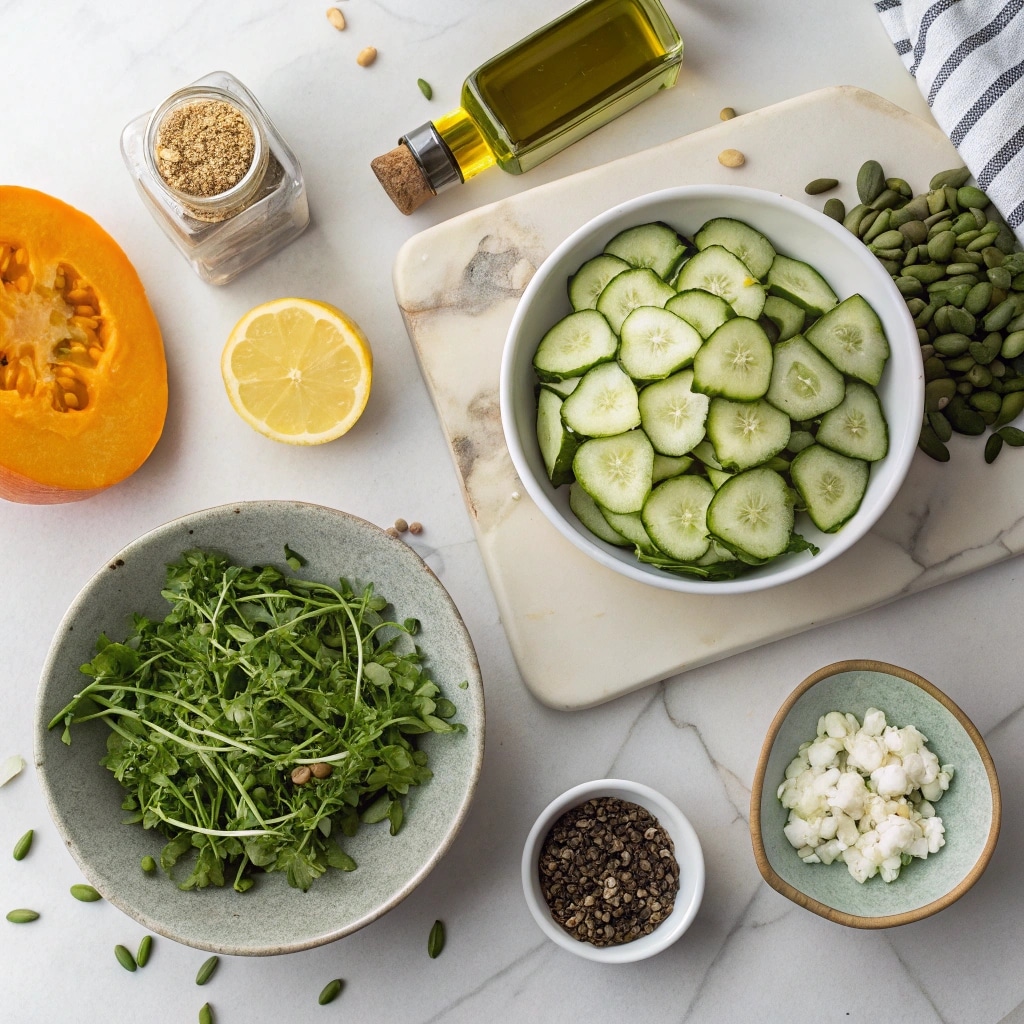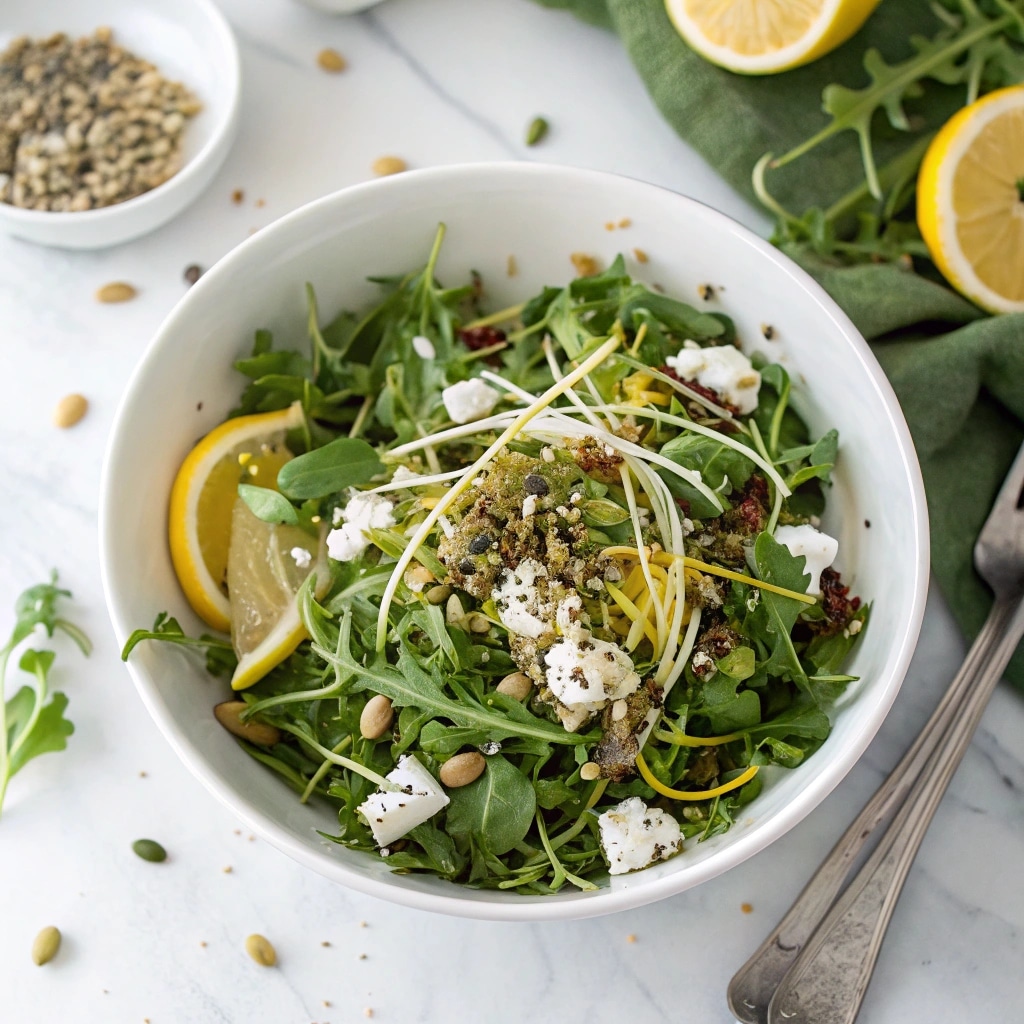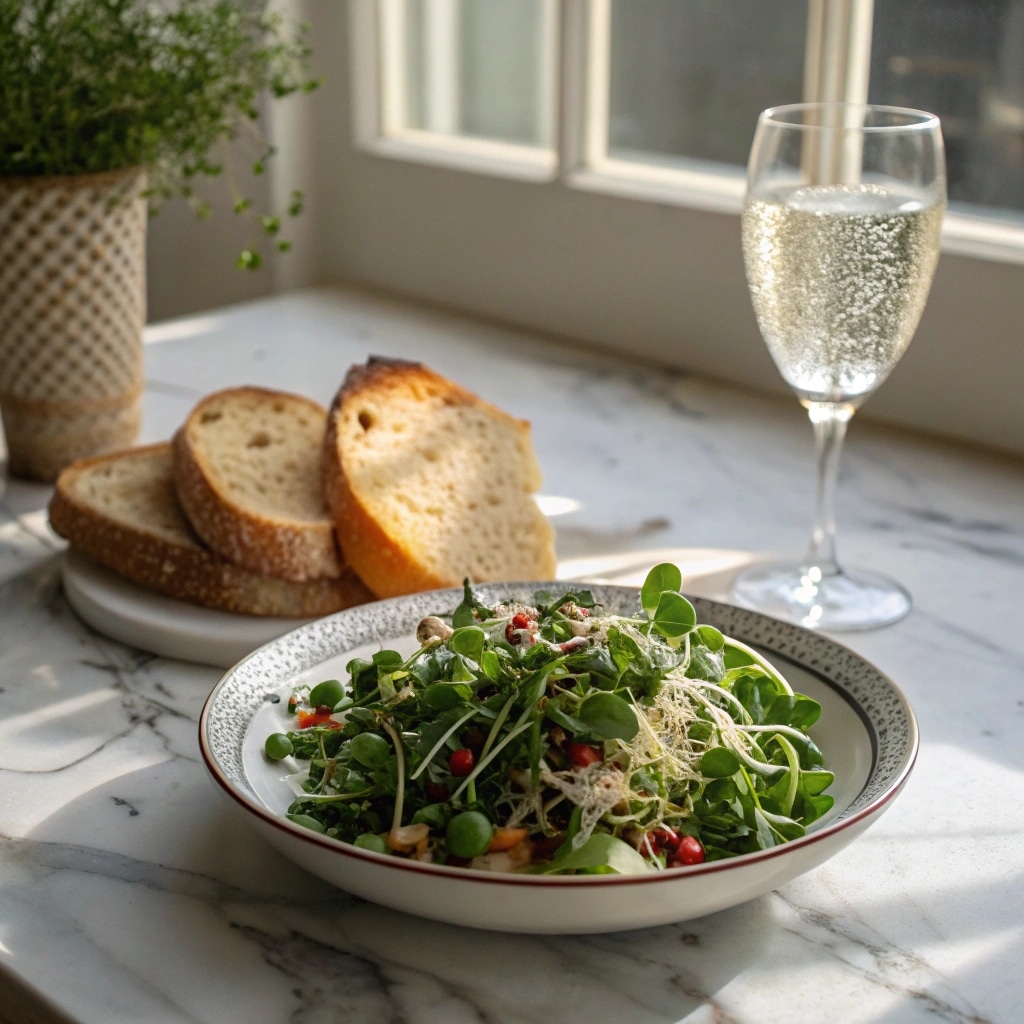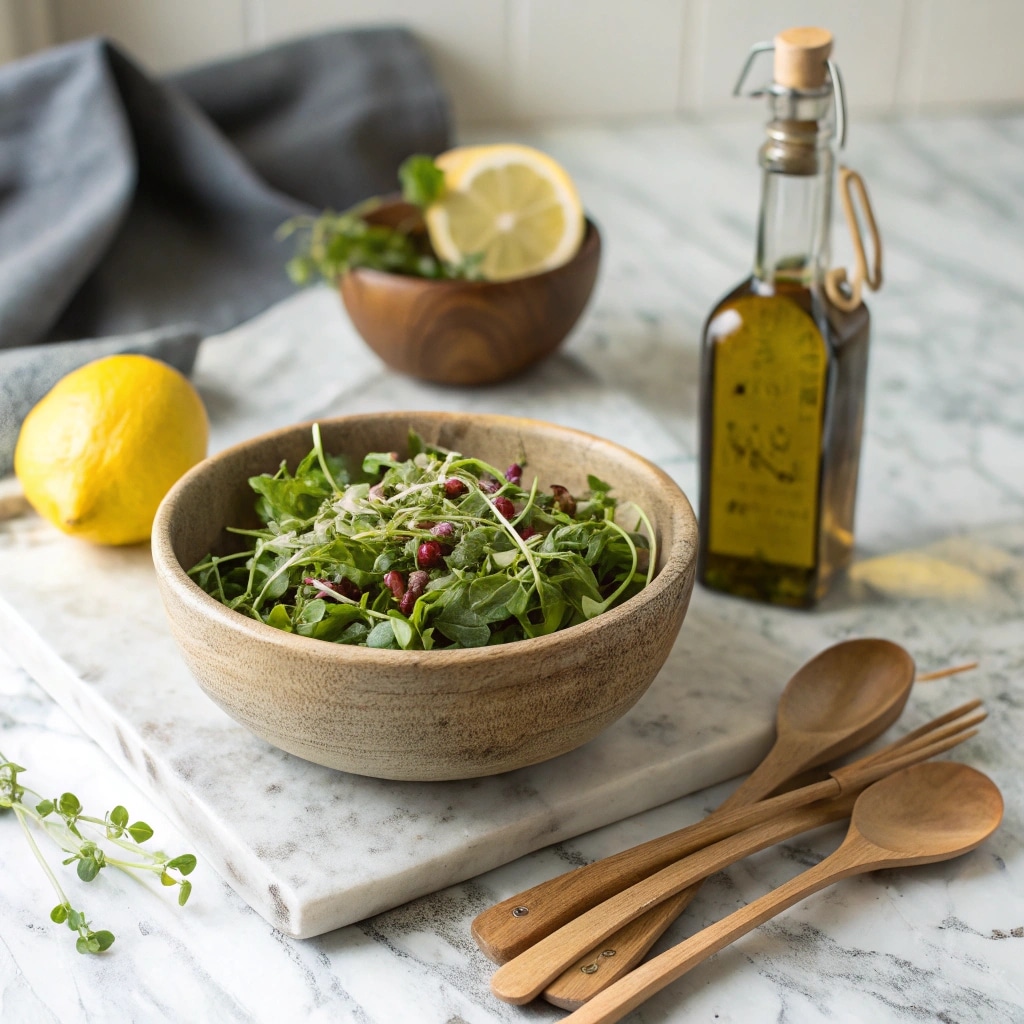Microgreens salad isn’t just a beautiful, trendy plate—it’s a bold way to bring flavor and nutrition to your everyday meals. I started tossing microgreens into dishes long before I knew how powerful they really were. Growing up in Vermont, I’d run into the garden and snatch little green shoots while my mom baked fresh rolls in her tiny bakery kitchen. We didn’t call it a “microgreens salad” back then—it was just lunch with what was growing outside.
These days, in my Asheville kitchen, trays of radish and broccoli microgreens sit near the window, soaking in the sunlight. I add them to nearly everything, but especially salads—where their textures and intense flavors shine. A handful of fresh sunflower microgreens, a drizzle of lemon vinaigrette, and suddenly, you’ve got a dish that feels like it belongs at a high-end café.
Table of Contents

Microgreens Salad Recipe That’s Fresh, Simple, and Packed with Flavor
- Total Time: 10 minutes
- Yield: 2 servings 1x
- Diet: Vegetarian
Description
A light, crisp, and nutrient-rich microgreens salad perfect for lunch or as a side to a hearty dinner.
Ingredients
2 cups mixed microgreens (radish, sunflower, broccoli, pea)
1/4 cup thinly sliced cucumber
2 tbsp toasted pumpkin seeds
1 tbsp crumbled goat cheese (optional)
2 tsp fresh lemon juice
1 tbsp olive oil
Pinch of sea salt
Cracked black pepper, to taste
Instructions
1. Rinse and gently dry the microgreens using a salad spinner or paper towel.
2. Add microgreens and cucumber slices to a large mixing bowl.
3. In a small bowl, whisk lemon juice, olive oil, salt, and pepper.
4. Drizzle the dressing over the microgreens and toss gently.
5. Top with toasted seeds and optional goat cheese.
6. Serve immediately for the freshest flavor.
Notes
Use any variety of microgreens based on taste preferences or what’s available locally.
To make it a complete meal, add grilled chicken, salmon, or chickpeas.
For added sweetness, toss in a few dried cranberries or sliced apples.
- Prep Time: 10 minutes
- Cook Time: 0 minutes
- Category: Salad
- Method: No-cook
- Cuisine: American
Nutrition
- Serving Size: 1 bowl
- Calories: 110
- Sugar: 1g
- Sodium: 180mg
- Fat: 9g
- Saturated Fat: 2g
- Unsaturated Fat: 7g
- Trans Fat: 0g
- Carbohydrates: 4g
- Fiber: 2g
- Protein: 3g
- Cholesterol: 5mg
A Fresh Start with Microgreens Salad
What makes a microgreens salad special is its punch. These baby greens aren’t just cute; they’re dense with nutrients—sometimes containing up to 40 times more vitamins than mature vegetables. They’re quick to grow, require little space, and are perfect for busy cooks looking for fast, healthy meals. Whether you’re building a salad bowl for one or prepping for a family dinner, microgreens bring both beauty and benefits to your plate.
If you enjoy quick, nutrient-packed meals like this, you’ll love my colorful and tangy retinol carrot salad—another quick favorite packed with vitamins and crunch.
How to Make the Perfect Microgreens Salad Bowl
Choosing the Best Microgreens for Your Salad
When making a flavorful microgreens salad, your choice of greens matters. Some varieties add a peppery bite, while others bring sweetness or crunch. Here are a few tried-and-true favorites:
- Radish microgreens – spicy and crisp
- Sunflower microgreens – nutty with great texture
- Broccoli microgreens – mildly earthy and nutrient-rich
- Pea shoots – sweet and tender
The real magic happens when you mix them. A blend of radish and sunflower adds depth, while broccoli and pea shoots soften and balance the punchier flavors. Toss them together with just a few simple add-ins, and you’ve got a salad that feels gourmet with hardly any effort.
Microgreens Salad Ingredients

Here’s what you’ll need for two servings:
- 2 cups mixed microgreens (radish, sunflower, broccoli, pea)
- 1/4 cup thinly sliced cucumber
- 2 tbsp toasted pumpkin seeds (or sunflower seeds)
- 1 tbsp crumbled goat cheese (optional)
- 2 tsp fresh lemon juice
- 1 tbsp olive oil
- Pinch of sea salt
- Cracked black pepper, to taste
Microgreens Salad Instructions

- Rinse and dry the microgreens gently using a salad spinner or paper towels.
- In a large bowl, combine the microgreens and sliced cucumber.
- Whisk together lemon juice, olive oil, sea salt, and pepper in a small bowl.
- Drizzle the dressing over the salad and toss lightly to coat.
- Top with pumpkin seeds and goat cheese (if using).
- Serve immediately for the best texture and flavor.
If you’re in the mood for something warm to round out your meal, serve this with my ultra-comforting potato chicken ranch casserole—it’s a perfect combo of creamy and crisp.
Microgreens Salad Benefits: Eat It Every Day? Yes, and Here’s Why
Can You Eat Microgreens Salad Every Day?
Absolutely—you can eat a microgreens salad every single day, and your body will thank you for it. These tiny greens might look delicate, but they pack a serious nutritional punch. In fact, studies show that microgreens can contain up to 4–40 times more nutrients than their mature counterparts, especially in vitamins like C, E, and K.
Take red cabbage microgreens, for example—they’re known for high levels of polyphenols and antioxidants, which help fight inflammation and support immune function. Broccoli microgreens are a favorite of mine and a powerhouse of sulforaphane, a compound linked to cancer prevention.
Eating microgreens daily as part of your salad can improve digestion, support detoxification, and give your skin a healthy glow. I toss them into smoothies, pile them on toast, and always make sure they show up in my lunch salad. They’re so light and easy to digest that I’ve never felt bogged down—just energized.
Microgreens: A Superfood That’s Simple
We often associate the word “superfood” with expensive powders or exotic fruits, but microgreens grow right on your kitchen counter. They don’t require soil if you use a sprouting mat, and within 7–10 days, you’ve got a fresh harvest. That’s faster than any grocery trip.
Because microgreens are so nutrient-dense, even a small portion boosts your vitamin intake. Start with a handful a day. Add it to a salad, sandwich, or wrap.
If you love adding healthy sides to your daily routine, you might also enjoy my classic killed lettuce salad, which mixes warm dressing with tender greens for a comforting bite.
What Are Microgreens? Understanding the Food Behind the Flavor

What Are Microgreens, Exactly?
A lot of folks hear the term microgreens salad and assume it’s just a plate of sprouts. But microgreens are different—and in many ways, even better. Microgreens are young vegetable greens, harvested just after the first true leaves develop. Unlike sprouts, which are germinated seeds eaten whole, microgreens are snipped above the root line and grown in soil or trays under sunlight.
They’re not just garnish. Microgreens are real food—dense with flavor, packed with nutrients, and surprisingly filling. You’ll find them grown from common veggies like radish, arugula, mustard, kale, and even herbs like basil or cilantro. Because they’re so concentrated, microgreens deliver deeper taste than the mature versions of the same plants.
Their crisp texture and intense flavor make them perfect for a salad that doesn’t rely on heavy dressings or complex prep.
How to Grow or Buy Microgreens for Salad Perfection
You can grow microgreens in a sunny kitchen window with just a shallow tray and some organic potting mix. Within a week, you’ll have a lush green bed ready to harvest with kitchen scissors. Radish and mustard are especially fast-growing—and they bring a spicy kick perfect for salads.
If gardening’s not your thing, no worries. Most farmers’ markets carry microgreens now, and grocery stores often stock them near the herbs. Just look for bright color and dry leaves—avoid anything soggy or dull.
Freshness is key. I always wash mine gently, then store in a paper towel-lined container in the fridge. They’ll stay crisp for 4–5 days.
And if you’re in the mood for something warm and cozy to go with your fresh salad, try this creamy chicken enchilada casserole with white sauce—a favorite in my kitchen for hearty meals.
Frequently Asked Questions about microgreens salad
Can you eat microgreens as a salad?
Yes, you absolutely can eat microgreens as a salad. In fact, a microgreens salad is one of the best ways to enjoy their flavor and nutrients. Toss them with a light vinaigrette or lemon juice to let their natural taste shine. They can stand alone or be mixed with other leafy greens for extra texture.
Is it OK to eat microgreens every day?
It’s not only OK—it’s smart! Eating a microgreens salad daily adds a powerful dose of vitamins, minerals, and antioxidants to your meals. Just rotate the types of microgreens you use to keep your nutrition balanced and exciting.
What are microgreens food?
Microgreens are young, edible greens harvested just after the first true leaves appear. They come from common veggies and herbs like radish, broccoli, kale, basil, and arugula. Used in a microgreens salad, they’re a nutrient-dense food option that brings strong flavor and health benefits.
What are the best microgreens for salads?
Some of the top picks for a microgreens salad include sunflower for crunch, radish for spice, pea shoots for sweetness, and broccoli for a mild, earthy note. A mix of 2–3 types often delivers the most satisfying flavor and texture combination.
Conclusion: A Salad That’s Small in Size, Big on Benefits
Creating a delicious, nourishing microgreens salad isn’t about perfection—it’s about fresh ingredients, simple prep, and a little creativity. Whether you grow them on your windowsill or pick them up at the market, microgreens bring bold flavor and serious nutrients to your plate.
If you’re ready to give it a try, start with one tray of radish or sunflower microgreens and pair them with pantry basics like olive oil, lemon, and salt. That’s all it takes to transform your salad game.




